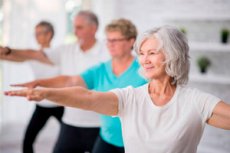
《营养素》杂志最近发表的一项研究调查了瑜伽和地中海饮食(MD)对老年人各种健康指标的综合影响。
西班牙老龄人口显著增长,目前约为20%,预计到2060年代将达到29%。随着年龄增长,生理变化会影响营养吸收、食欲和营养不良的风险,同时脂肪质量比例也会增加,肌肉质量也会下降。
由于体力活动减少,以及年龄相关的结缔组织和本体感觉的变化,老年人的身体机能也会下降,包括柔韧性、平衡性和肌肉力量。这些变化会增加跌倒、受伤和生活质量下降的风险。
饮食和运动等策略对于对抗这些影响至关重要。地中海饮食强调植物性食物,适量食用鱼类、家禽和乳制品,并限制红肉的摄入,能够提供维持整体健康所需的营养。
运动,尤其是瑜伽等身心疗法,能带来显著益处。瑜伽可以改善营养吸收和消化,增强柔韧性、活动范围和肌肉力量,从而有助于改善老年人的整体健康状况和功能独立性。
本研究旨在评估地中海饮食和瑜伽对老年人营养和功能健康的综合影响。
研究人员采用随机对照试验来检查包括瑜伽和地中海饮食在内的 12 周干预对非机构老年人的灵活性、平衡性、握力和下半身力量的影响。
样本包括 118 名 65 岁及以上的参与者,他们通过电话和电子邮件招募,并符合最近没有参加过瑜伽和能够理解程序说明等标准。
参与者被随机分配到实验组或对照组,每组有 59 名参与者,使用计算机系统,参与者和研究人员都不知道小组分配情况。
实验组每周参加两次瑜伽课程并遵循地中海饮食,而对照组则继续正常活动和饮食。
收集的数据包括人口统计信息、地中海饮食的遵守情况、营养、灵活性、平衡性和肌肉力量,并在干预前后进行评估。
数据分析包括各种统计测试,包括单因素方差分析 (ANOVA) 来比较干预前后的结果,显着性水平设定为 p < 0.05,并使用 Cohen's d 计算效应大小。
这项研究的参与者中男性占36.96%,女性占63.04%。参与者对干预的依从性很高(91.6%)。没有记录到任何损伤或不良反应。
经过瑜伽和地中海饮食的联合干预,各项健康指标均有明显改善。
坚持地中海饮食后,随着时间的推移,各组之间存在显著的差异和改善,且效果显著(Cohen's d = 2.18)。营养状况也显著改善,尽管各组差异较小(Cohen's d = 0.05)。
平衡和步态显示出中度改善,干预后存在显著差异(平衡的 Cohen's d = 0.40,步态的 0.42)。
身体各部位的灵活性均得到显著提高,对右臂和左腿的影响更为显著(Cohen's d = 0.43 和 0.37)。
研究还发现,接受地中海饮食并结合瑜伽的组在干预前后的肌肉力量测量结果差异更大。
具体来说,下半身力量和握力表现出显著差异(握力的Cohen's d = 0.39,下半身力量的Cohen's d = 0.81)。
研究得出的结论是,将地中海饮食与瑜伽相结合的 12 周干预措施可以显著改善非机构老年人的营养、平衡、步态、跌倒风险、灵活性和肌肉力量。
这些结果与之前的研究一致,表明体育活动和地中海饮食对老年人有益。
该研究的优势包括其随机、对照和盲法设计、参与者依从性高以及样本量大,从而提高了结果的可靠性。
然而,该研究存在一些局限性,例如无法对参与者进行盲测、评估效果的短期性以及干预的综合性,因此很难分离出瑜伽或饮食的具体贡献。
未来的研究应该考虑为每项干预措施设计单独的组,以便更好地了解它们的个体效果。
尽管存在这些局限性,该研究强调了运动和饮食干预对于改善老年人健康和福祉的重要性,这可能有助于制定促进健康老龄化和减轻慢性病负担的公共卫生政策。

